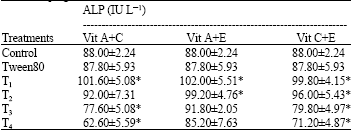Research Article
Effects of Antioxidant Vitamin Combination on Pregnancy Induced Hyper-Hepatic State
Department of Pharmacology and Therapeutics, College of Medicine, Ambrose Alli University, Ekpoma, Edo State, Nigeria
J. E. Emordi
Department of Pharmacology and Therapeutics, College of Medicine, Ambrose Alli University, Ekpoma, Edo State, Nigeria
E. O. Nwoke
Department of Physiology, College of Medicine, Ambrose Alli University, Ekpoma, Edo State, Nigeria
B. O. Idonije
Department of Chemical Pathology, College of Medicine, Ambrose Alli University, Ekpoma, Edo State, Nigeria
U. Akpamu
Department of Physiology, College of Medicine, Ambrose Alli University, Ekpoma, Edo State, Nigeria












